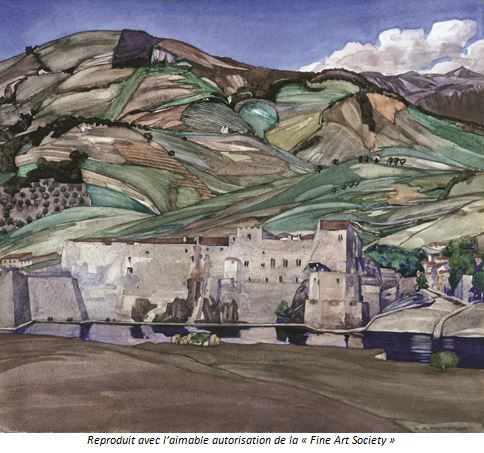
Watercolour 14
Summer Palace of the Queens of Aragon

1924
38.1 x 43.2 cm
The National Trust for Scotland, The Hill House
Charles Rennie Mackintosh and his wife Margaret had heard from close friends – Rudolf Ihlee and Edgar Hereford, both residing in Collioure, that life was cheap there. Charles Rennie Mackintosh had the idea of committing himself to painting the landscapes and particularly the villages that he discovered during his journey in Roussillon.
It was probably at the beginning of the summer of 1924 that he produced this painting which represents the south face of the Royal Castle of Collioure – the “Summer Palace of Queen of Aragon”.
The vantage point
We are on the road at the entrance to Collioure coming from Port-Vendres on a median located on the right. From this height we have a very beautiful view on the village of Collioure and its bay, and we look towards the West, North-West in the direction of the Royal castle of Collioure.
The painting represents the south-west face of the Royal Castle of Collioure and in the background are the hills which dominate to the north of Collioure.
The castle has changed little since that time. On the other hand, in the background, many constructions have been built up on the hill and make the landscape very different from the days of Charles Rennie Mackintosh, when there were all fields and meadows.
Pictorial analysis
- “Mackintosh placed himself near the water’s edge, on the side of the main bay of the port which faces the 17th century Fort Miradou. He emphasized this defensive stronghold, which juts out like the prow of a ship. Only a small group of four fishing boats on the opposite shore is included. In “the Chronycle”, Mackintosh laments his preference for green. Here, however, his painting resonates with vibrant shades of blue in the sea and shadows. Translated from English by kind permission of the author: Professor Pamela Robertson – University of Glasgow – translation S.Plas
The royal castle
The royal castle of Collioure (in Catalan Castell Reial de Cotlliure) was erected in the 7th century and then rebuilt from the 13th to the 17th century. As we see it today is the result of multiple transformations on the part of its various owners, over the periods and vicissitudes of history. Now it belongs to the Departmental Council which organizes visits and events there. A visit is essential. One travels through history and discovers superb views of the town, the port and its surroundings. This castle, with its defenses, scarps and counter-scarps, has been classified as a historical monument since November 14, 1922.
Quoted as early as 672, the castle has accumulated seven centuries of work within its walls. It consists of several buildings superimposed and, or, juxtaposed.
Three major construction phases can be distinguished:
Firstly, a Templar castle for port defense, the castle was completely rebuilt by the kings of Majorca in the 13th century to become their summer residence. In the 14th century, the kings of Aragon reorganized the fortifications to make it a military fortification. In the 17th century, Vauban, under Louis XIV, King of France, erected the outer enclosure, razed the village within the ramparts and fitted out the glacis.
In 1939 the fortress was transformed into a prison and served as a detention camp for Spaniards fleeing Francoism. In 1952 it will be bought by the county council to restore it, open it to the public and bring it to life.
In 1962 it housed many families repatriated from Algeria at the end of the war of independence. For further information and to find out what the site is about, visit the Royal Castle of Collioure department site page:
www.ledepartement66.fr/dossier/le-chateau-royal-de-collioure/